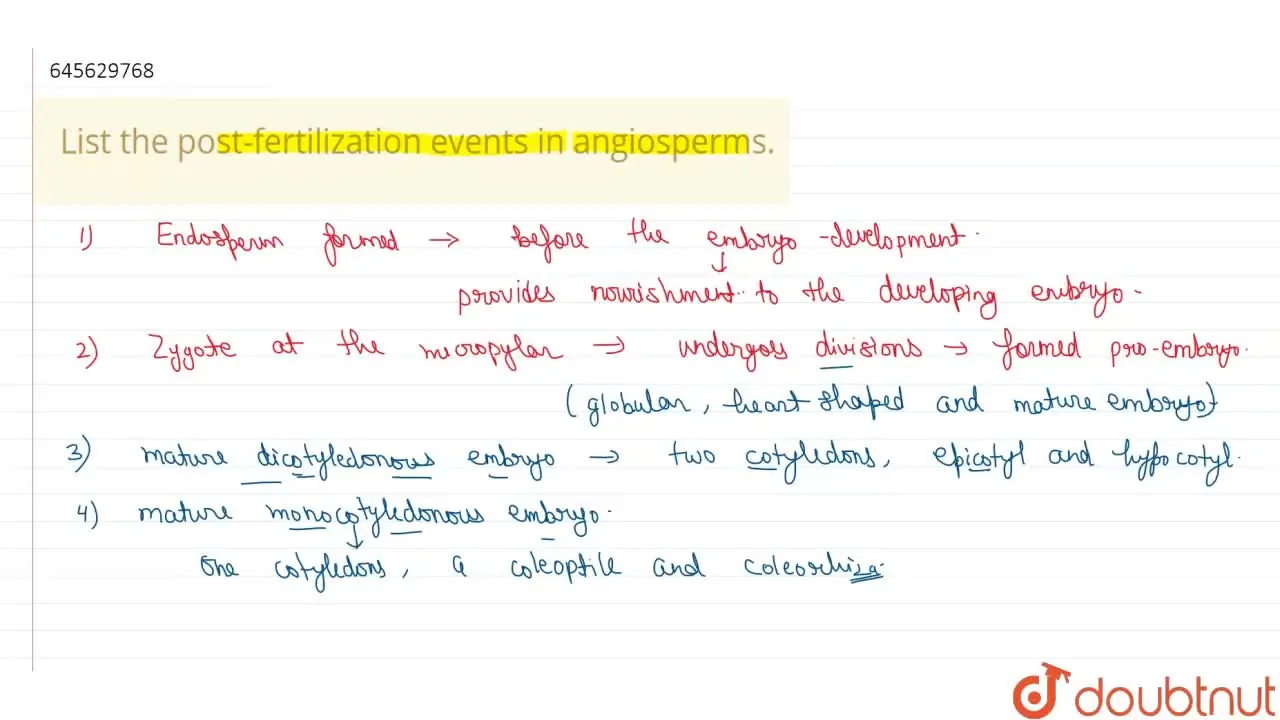List the post-fertilization events in angiosperms. Solution in Punjabi
Post-fertilization Evnets. These events may be described under two headings-zygote and embryogenesis.
(a) Zygote. In all sexually reproducing organisms a diploid zygote is formed as a result of fertilization. Later, tbe zygote produces a new individual. The development of zygote depends on the type of life cycle of tbe organism and tbe environment. In many algae and fungi, the zygote develops a thick wall forming zygospore and undergoes a period of rest before germination.
(b) Embryogenesis. The process of development of embryo from the zygote is called embryogenesis. Embryonic development involves cell ision (Mitotic) and cell differentiation. Cell divisions increase tbe number of cells in the developing embryo and cell differentiation leads to formation of different kinds of tissues and organs in an organism. Depending upon the development of zygote inside or outside tbe body of the female parent, animals are classified into oviparous and viviparous.
Oviparous animals lays eggs, for example-amphibians, fishes, reptiles and birds, while viviparous animals give birth to young ones, e.g., majority of mammals including human beings.
In some oviparous animals like reptiles and birds the fertilized eggs remain covered by hard· calcareous shell. Such eggs are called cledoic eggs.
In viviparous organisms, tbe chance of survival. of young ones is greater because they are delivered out of the body of the female parent after attaining a certain stage of growtb thus get proper embryonic care and protection.
In flowering plants, tbe zygote is formed inside the ovule. After fertilization tbe sepals, petals and stamens of tbe flower usually fall off except in case of tomato, brinjal, where sepals maypersist. The zygote develops into tbe embryo and tbe ovules develop into tbe seed. The ovary develops into the fruit and the ovary wall is transformed into a protective layer, pericarp.

Related Playlists
- BOOK - BETTER CHOICE PUBLICATIONCHAPTER - REPRODUCTION IN ORGANISMSEXERCISE - SHORT ANSWER TYPE QUESTIONS (3 MARKS)13videos
REPRODUCTION IN ORGANISMS
- BOOK - BETTER CHOICE PUBLICATIONCHAPTER - PRINCIPLES OF INHERITANCE AND VARIATION EXERCISE - LONG ANSWER TYPE QUESTIONS31videos
PRINCIPLES OF INHERITANCE AND VARIATION
- BOOK - BETTER CHOICE PUBLICATIONCHAPTER - REPRODUCTIVE HEALTHEXERCISE - MOST EXPECTED QUESTIONS26videos
REPRODUCTIVE HEALTH
Similar Questions
What is fission? What is the basic difference between fission in amoeba and paramecium?
03:02View SolutionState and explain Mendel's law of independent assortment with the help of a dihybrid cross.
04:35View SolutionExpand ICSI.
06:10View SolutionWhat is not a post fertilization event
06:25View SolutionThe correct sequence of events during double fertilization of angiosperms is
02:42View SolutionList the post-fertilization events in angiosperms.
01:35View Solutionएक आवृतबीजी पौधे के पुष्प में निषेचन पश्च परिवर्तनों की व्याख्या कीजिए ।
40:56View SolutionWhich of the following is not included in post - fertilization events?
03:00View SolutionList the post fertilization changes in a flower .
03:48View SolutionPost Fertilization Events|Embryogenesis
01:56View SolutionList the post-fertilization events in angiosperms.
02:39View SolutionExplain Post Fertilization events.
02:13View Solutionउपरोक्त में से कौनसा प्रक्रम निषेचन पश्च घटना है ?
01:34:30View SolutionWhich of the following is a post - fertilization event in flowering plants ?
45:42View SolutionFill up the blanks after reading the statement.
Post-fertilization events in angiosperms.
Zygote : Embryo
Ovule : _____
Ovary : _____01:53View SolutionFertilization or Syngamy || Post Fertilization Events || Embryogenesis
43:09View Solution


